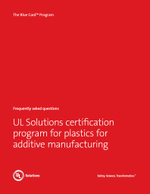
Blue Card Frequently Asked Questions
Get answers to frequently asked questions about UL Solutions' Blue Card™ Program which demonstrates third-party certification that your material is appropriate for 3D printing.

The Blue Card™, formally known as UL’s certification program for plastics for additive manufacturing, certifies plastic materials that are appropriate for 3D printing (3DP). More specifically, the Blue Card provides data to facilitate the preselection of 3D printed materials and components intended for use in various end-product applications from automotive to appliances and many others. It helps deliver confidence and trust across the supply chain — to both users and suppliers of 3D printed articles in terms of their quality, safety, consistency and performance.
As the usage of 3D printing expands beyond rapid prototyping and into serial production applications, materials-related issues are being reported as the biggest barrier to even faster mainstream growth. The current set of materials available for additive manufacturing users to choose from is a small fraction of the materials available for traditional processes like injection molding. The challenges reported with current materials include cost, a lack of confidence in the reliability and consistency of the parts produced from them, and a lack of certified materials available in the marketplace.(1) These issues are magnified in more highly regulated industries such as aerospace and healthcare, to name a few. Industry-wide AM standards and specifications for precursor materials need to be established and published. In their absence, the AM industry has relied upon existing standards and specifications that were developed decades ago based on conventional manufacturing methods, which often are
unsuitable for additive manufacturing.(2)
(1) Jabil, ‘Current State of Additive Material and 3D Printing’, January 2019
(2) Deloitte Insights, 3D Opportunity for standards. Additive manufacturing measures up’, 2017
UL Solutions' plastics experts conducted a systematic research study to fill in the knowledge gap. To obtain the information needed, the team investigated the influence of various 3D printing and build parameters on safety-critical performance properties, especially those defined in UL 94, the Standard for Safety of Flammability of Plastic Materials for Parts in Devices and Appliances testing, and UL 746A, the Standard for Polymeric Materials – Short Term Property Evaluations. Results were also compared to properties measured on injection molded specimens. The learnings from this research led to the creation of UL Solutions' certification program for Plastics for Additive Manufacturing (Blue Card). Certified materials help product/part designers make intelligent material selection decisions, while reducing their development time and ensuring compliance.
A certified material is a material that has gone through third-party testing and evaluation to validate its performance in accordance with a specific printer and settings. Third party certification makes it easier for original equipment manufacturers (OEMs) to adopt materials for mainstream AM production as it reduces the testing burden required on their components and products. Blue Card certification delivers confidence to users that the material performance remains consistent as the material is regularly inspected through UL Follow-Up Services program to ensure its continued compliance and certification. Self-declared ratings cannot be used to make certification decisions on end products. Products utilizing self-declared material ratings will face longer, more expensive certification pathways (due to increased testing requirements) versus products/components made from certified Blue Card materials.
Anyone in the AM supply chain can apply for the Blue Card. For example, a 3D printer manufacturer or material manufacturer can apply for the Blue Card. Whoever applies for the Blue Card is called the applicant and receives the right to apply the UL Solutions Recognition Mark to the product.
It is possible to have two Blue Cards, or a joint Blue Card — one with the applicant (material manufacturer) and the second with the printer manufacturer. This enables both the material manufacturer and printer manufacturer to market the material individually. Since it’s the same investigation, we can divide the project in half and each applicant can split the costs.
Because there are many variables surrounding recognition of additive manufacturing materials, the process to obtain a Blue Card starts with a certification requirement investigation project. We work directly with you to determine pertinent variables such as printer models, printing and build parameters, and any post-processing information to accurately determine what is required. After these requirements are finalized, we provide a detailed quotation for the full investigation along with sample requirements and an outline of the testing to be performed. Once your project is underway, we provide secure online access to your project status through the myUL™ Client Portal while you work with dedicated engineering resources to help ensure timely material certification.
Once your material is UL Certified, it will appear in UL Solutions' online Product iQ™ certification database, making it immediately visible to thousands of designers, engineers and suppliers searching for a material intended for 3D printing. Only materials that have been certified by UL Solutions appear in Product iQ, so you know that the material has been evaluated by an independent third-party.
Unfortunately, due to the printing process, ratings from the Yellow Card do not carry over to the AM materials and have to be evaluated separately, with the specific printer and parameters. This is due to the possibility of different equipment resulting in different performance. UL Solutions' plastics experts completed a 14-month long study on this. The detailed research report can be downloaded here.
Each unique material grade should have a separate Blue Card. A given Blue Card can include multiple printers if the print parameters and performance properties are the same for these different printers. If print parameters and/or the printed properties differ for different model printers, multiple Blue Cards can be issued or multiple printer/processing designations can be used to highlight differences.
For example, if a material obtains a V-0 rating with one model printer and a V-2 with a different model printer, we would establish two Blue Cards in order to differentiate the performance.
Not necessarily. We will work with you to evaluate printer equivalency. If there are differences, we will work with you to develop a reduced test program to help ensure consistent performance of the material across both platforms. A revised or new Blue Card will be issued to capture the usability of materials across both platforms.
UL Solutions does have a confidential solution. It is possible to have a proprietary Blue Card. Proprietary cards can still be accessed via the Product iQ database, so it will still be visible to the thousands of individuals searching this database for recognized materials, but the only publicly viewable information is your company name. No product names or ratings are viewable. The process to obtain a proprietary Blue Card is the same as a published Blue Card.
The applicant decides what testing properties they would like listed on the Blue Card. Typically, flammability is always performed and, depending on the application of the material, other testing may be requested. Only UL-evaluated material performance properties are listed on the material’s Blue Card. If properties are not listed, either UL Solutions has not evaluated the property or the applicant decided not to publish that information.
The number of parts and time required for validation ultimately depends upon the product category. Validation of a 3D printed part will be the same as a conventionally manufactured part provided both are made from UL Solutions recognized materials. The evaluation of 3D printed parts made using Blue Card recognized materials will be faster than for parts made using unrecognized materials due to reduced testing.
For more information visit www.UL.com/BlueCard.

Blue Card Frequently Asked Questions
Have questions, need specifics? Let's get this conversation started.